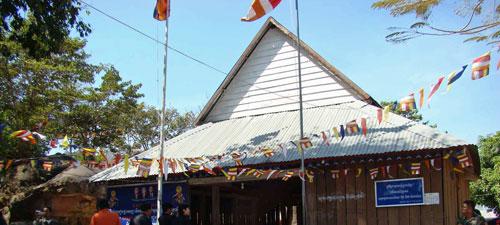Preah Vihear tense after influx of Cambodian troops
The government will flex its muscles for the protesting yellow shirts from the People's Alliance for Democracy (PAD) to show it will protect land in disputed border areas. It plans to issue a statement of protest against Cambodia.
Prime Minister Abhisit Vejjajiva has instructed the Foreign Ministry to issue a protest, because Phnom Penh has refused to remove its national flag from the disputed area adjacent to the Hindu temple at Preah Vihear, the ministry spokesman Thani Thongpakdi said.
"Concerned officials are working on it and we could issue the statement soon," he said. Abhisit said last week that Cambodia had no right to fly its national flag at Wat Keo Sikkha Kiri Svara temple as Thailand also claimed territorial rights to the area.
Thailand managed to convince Cambodia to remove two stone tablets saying the area where Thai troops invaded in 2008 belonged to Cambodia.
However Phnom Penh refused to follow any further demand from Bangkok to remove its national flag there. It says the temple built by Cambodian people in 1998 is clearly situated in Cambodian territory.
"Therefore the national flag of Cambodia is legitimately able to fly over the pagoda," a statement by Cambodia's Foreign Ministry said last week.
The border area adjacent to Preah Vihear has been argued over ever since the International Court of Justice (ICJ) ruled in 1962 that the temple was situated in Cambodian territory.
Abhisit has argued that the ICJ ruled only the stone ruins belong to Cambodia while surrounding areas belong to Thailand.
The areas have not been demarcated yet but the two countries signed a memorandum of understanding in 2000 to set up a joint mechanism to try to settle the dispute.
The PAD, which has staged a rally near the Prime Minister Office, wants Abhisit to use force to remove Cambodians from the disputed area and scrap the 2000 MOU on land boundary demarcation. They have pressured the government by vowing to stay until their demands are met.
Cambodia, meanwhile, is reported to have boosted troops in the area, notably near Preah Vihear. Thai news teams have said the border areas are tense while outlets in Phnom Penh have reported that the Cambodian military is ready for war with Thailand.
Abhisit insisted he would settle the border dispute with Cambodia by peaceful means. The 2000 MOU was an effective instrument for settling the border dispute, he said.
Deputy Prime Minister Suthep Thaugsuban, who oversees security matters, said the Thai military was strong enough to protect the country but would not boost forces in the area near the historic temple.
The government would continue to negotiate with Cambodia over the border issue, he said.
"Please do not provoke any news to create tension with our neighbouring country. We have to live with them peacefully," Suthep said when asked about Cambodian troops along the border.
"We don't have any problem with Cambodia and our two governments have no problem," he said.
Asked if the government in Phnom Penh criticised Thailand every day, Suthep said, "don't look only at one side. If you are in Cambodia, you would see a group of Thai people scolding Cambodia every day."
















